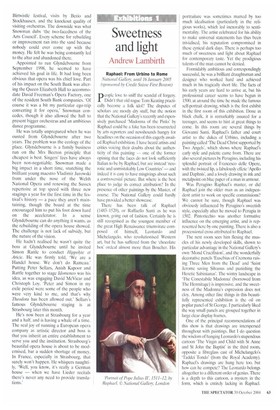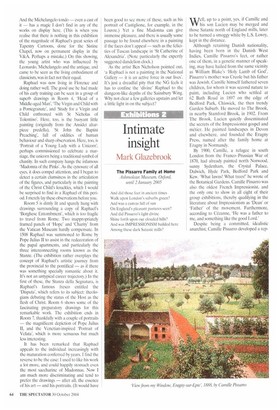Sweetness and light
Andrew Lambirth
Raphael: From Urbino to Rome National Gallery, until 16 January 2005 (sponsored by Credit Suisse First Boston)
people love to sniff the scandal of forgery. Didn't that old rogue Tom Keating practically become a folk idol? The disputes of scholars are mostly dry stuff, but the notion that the National Gallery's recently and expensively purchased `Madonna of the Pinks' by Raphael could he a fake has been resurrected by arts reporters and newshounds hungry for headlines on the occasion of this eagerly awaited Raphael exhibition. I have heard artists and critics voicing their doubts about the authen
ticity of this painting one of the former opining that the faces do not look sufficiently Italian to be by Raphael, but are instead 'neurotic and unmistakably Low Countries' — and indeed it is easy to have misgivings about such a controversial picture. But where is the best place to judge its correct attribution? In the presence of other painting, by the Master, of course. The National Gallery could hardly have provided a better showcase.
There has been talk of Raphael (1483-1520), or Raffaello Santi as he was known, going out of fashion. Certainly he is still recognised as the youngest member of the great High Renaissance triumvirate composed of himself, Leonardo and Michelangelo, who revolutionised Western art, but he has suffered from the 'chocolate box' ordeal almost more than Boucher. His portraiture was sometimes marred by too much idealisation (particularly in the religious works), which led inexorably to sentimentality. The artist celebrated for his ability to make universal statements has thus been trivialised, his reputation compromised in these cynical dark days. There is perhaps too much of sweetness and light about Raphael for contemporary taste. Yet the prodigious talents of the man cannot be denied.
Formidably ambitious and correspondingly successful, he was a brilliant draughtsman and designer who worked hard and achieved much in his tragically short life. The facts of his early years are hard to arrive at, but his professional career seems to have begun in 1500, at around the time he made the famous self-portrait drawing, which is the first exhibit in the first room of this exhibition. Done in black chalk, it is remarkably assured for a teenager, and seems to hint at great things to come. In this room are several things by Giovanni Santi, Raphael's father and court artist to the dukes of Urbino, including a painting called 'The Dead Christ supported by Two Angels', which shows where Raphael's early style and palette came from. There are also several pictures by Perugino, including his splendid portrait of Francesco delle Opere, with the twisted lip, a fabulously effete 'Apollo and Daphnis', and a lovely drawing in ink and metalpoint on blue paper of a man in armour.
Was Perugino Raphael's master, or did Raphael join the older man as an independent artist to work on specific commissions? We cannot be sure, though Raphael was obviously influenced by Perugino's sweetish style, especially after he moved to Perugia in 1502. Pintoricchio was another formative influence on the emerging artist, and is represented here by one painting. There is also a processional cross attributed to Raphael.
The next room sees him flexing the muscles of his newly developed skills, shown to particular advantage in the National Gallery's own 'Mond Crucifixion', and the wonderfully decorative panels 'Eusebius of Cremona raising Three Men from the Dead' and 'Saint Jerome saving Silvanus and punishing the Heretic Sabinianus'. The wintry landscape in The Conestabile Madonna' (borrowed from The I lermitage) is impressive, and the sweetness of the Madonna's expression does not cloy. Among other fine things in this beautifully represented exhibition is the oil on poplar panel of St George. I particularly liked the way small panels are grouped together in large clear display frames.
One of the principal recommendations of this show is that drawings are interspersed throughout with paintings. But I do question the wisdom of hanging Leonardo's stupendous cartoon 'The Virgin and Child with St Anne and St John the Baptist' in the third room, opposite a fibreglass cast of Michelangelo's 'Taddei Tondo' (from the Royal Academy). Raphael's drawings are hung here too, but how can he compete? The Leonardo belongs altogether to a different order of genius. There is a depth to this cartoon, a mystery in the form, which is entirely lacking in Raphael. And the Michelangelo tondo — even a cast of it — has a magic I don't find in any of the works on display here. (This is when you realise that there is nothing in this exhibition of the magnitude of Raphael's great series of Tapestry Cartoons, done for the Sistine Chapel, now on permanent display in the V&A. Perhaps a mistake.) On this showing, the young artist who was influenced by Leonardo. Michelangelo and the antique, and came to be seen as the living embodiment of classicism, was in fact not their equal.
Raphael was now living in Florence and doing rather well. The good use he had made of his early training can be seen in a group of superb drawings in Room 4, 'Head of a Middle-aged Man', 'The Virgin and Child with a Pomegranate', and 'Study for a Virgin and Child enthroned with St Nicholas of Tolentino'. Here, too, is the buoyant little painting (originally from the Ansidei altarpiece predella), 'St John the Baptist Preaching', full of oddities of human behaviour and sharp observation. Here, too, is 'Portrait of a Young Lady with a Unicorn', perhaps commissioned to celebrate a marriage, the unicorn being a traditional symbol of chastity. In such company hangs the infamous 'Madonna of the Pinks'. As the cynosure of all eyes, it does compel attention, and I began to detect a certain clumsiness in the articulation of the figures, and particularly in the painting of the Christ Child's knuckles, which I would be surprised to find in a Raphael of this period. I merely lay these observations before you.
Room 5 is dimly lit and sparely hung with drawings surrounding a copy of Raphael's 'Borghese Entombment', which is too fragile to travel from Rome. Two inappropriately framed panels of 'Hope' and 'Charity' from the Vatican Museum hardly compensate. In 1508 Raphael was summoned to Rome by Pope Julius II to assist in the redecoration of the papal apartments, and particularly the three interconnecting rooms known as the Stanze. (The exhibition rather overplays the concept of Raphael's artistic journey from the provincial to the pontifical — as if there was something specially romantic about it It's not an untypical career trajectory.) In the first of these, the Stanza della Segnatura, is Raphael's famous fresco entitled the Disputa', which refers to its subject: theologians debating the status of the Host as the flesh of Christ. Room 6 shows some of the fascinating preparatory drawings for this remarkable work. The exhibition ends in Room 7, thankfully with a couple of portraits — the magnificent depiction of Pope Julius II, and the Venetian-inspired 'Portrait of Velata', which is more sensuous hut much less interesting.
It has been remarked that Raphael appeals to the individual increasingly with the maturation conferred by years. I find the reverse to be the case: I used to like his work a lot more, and could happily stomach even the most saccharine of Madonnas. Now I am much more discriminating and tend to prefer the drawings — after all, the essence of his art — and his portraits. (It would have been good to see more of these, such as his portrait of Castiglione, for example, in the Louvre.) Yet a fine Madonna can give immense pleasure, and there is usually some passage to be found elsewhere in a painting if the faces don't appeal — such as the felicities of Tuscan landscape in 'St Catherine of Alexandria'. (Note particularly the expertly suggested dandelion clock.)
As the artist Ben Nicholson pointed out, 'a Raphael is not a painting in the National Gallery — it is an active force in our lives'. It's just a dreadful pity that the NG feels it has to confine the 'divine' Raphael to the dungeon-like depths of the Sainsbury Wing. Why not clear a few galleries upstairs and let a little light in on the subject?



















































































































 Previous page
Previous page